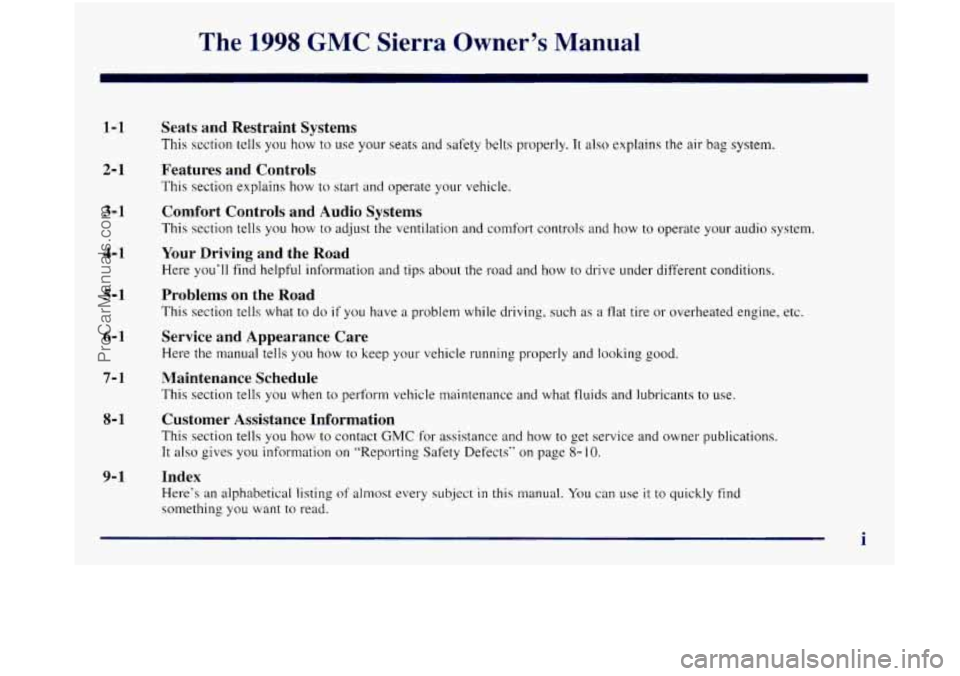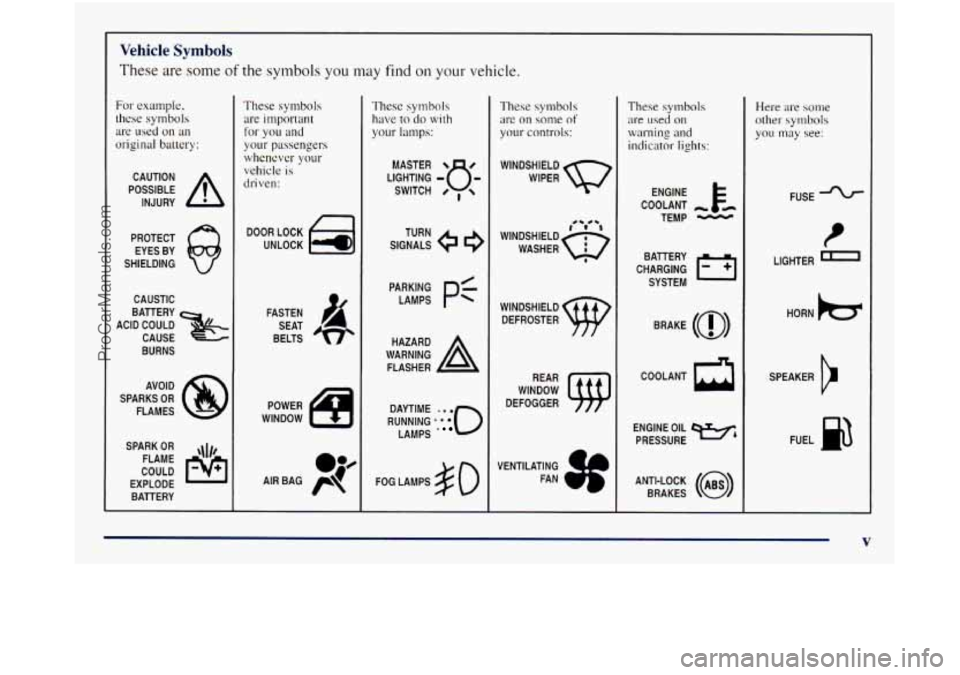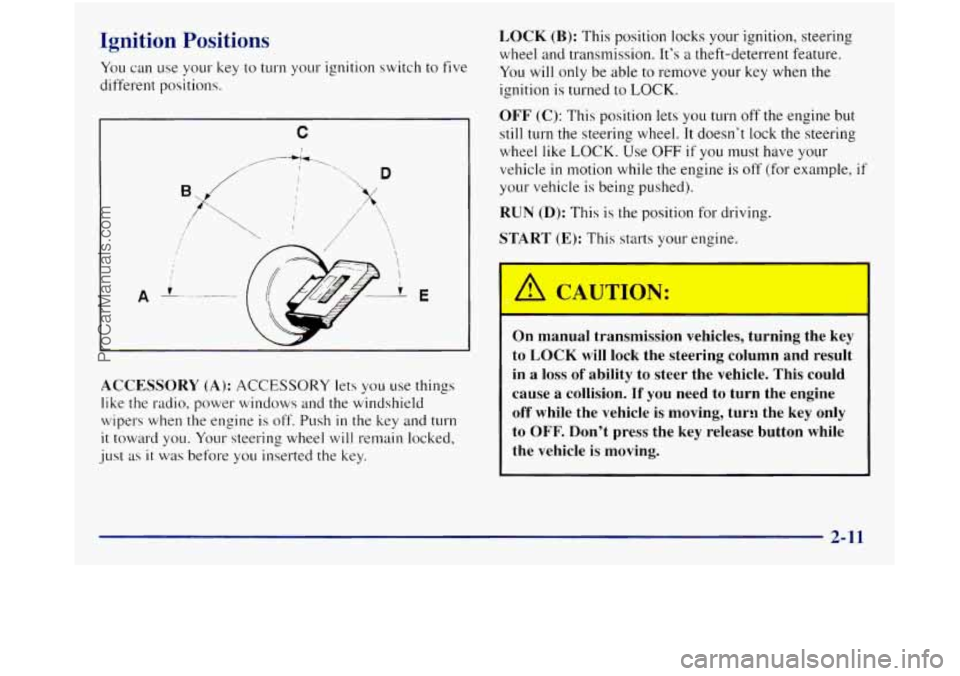1998 GMC SIERRA engine
[x] Cancel search: enginePage 7 of 452

The 1998 GMC Sierra Owner's Manual
1-1
2- 1
3- 1
4- 1
5-1
6-1
7-1
8- 1
9-1
Seats and Restraint Systems
This section tells you how to use your seats and safety belts properly. Tt also explains the air bag system.
Features and Controls
This section explains how to start and operate your vehicle.
Comfort Controls and Audio Systems
This section tells you how to adjust the ventilation and comfort controls and how to operate your audio system.
Your Driving and the Road
Here you'll find helpful information and tips about the road and how to drive under different conditions.
Problems on the Road
This section tells what to do if you have a problem while driving? such as a flat tire or overheated engine, etc.
Service and Appearance Care
Here the manual tells you how to keep your vehicle running properly and looking good.
Maintenance Schedule
This section tells you when to perform vehicle maintenance and what fluids and lubricants to use.
Customer Assistance Information
This section tells you how to contact GMC for assistance and how to get service and owner publications.
It also gives you information on "Reporting Safety Defects" on page 8- 10.
Index
Here's an alphabetical listing of almost every subject in this manual. You can use it to quickly find
something you want to read.
i
ProCarManuals.com
Page 11 of 452

Vehicle Symbols
These are some of the symbols you may find on your vehicle.
For example.
these symbols are used
on an
originnl battery:
POSSIBLE A
CAUTION
INJURY
PROTECT EYES BY
SHIELDING
CAUSTIC
ACID COULD
BATTERY
CAUSE
BURNS
AVOID
SPARKS
OR
FLAMES
SPARK
OR ,\I/,
COULD FLAME
EXPLODE BATTERY
These symbols are important
for you
and
your passengers whenever your
vehicle is
driven:
DOOR LOCK
UNLOCK
FASTEN SEAT
BELTS
POWER
WINDOW
These symbols
have to do with
your lamps:
SIGNALS e e
TURN
RUNNING
*'***'O
DAYTIME LAMPS
*
FOG LAMPS # 0
These symbols
are on some of
your controls:
WIPER Q
WINDSHIELD
DEFROSTER
WINDOW
DEFOGGER
VENTILATING FAN
These symbols
are used on
warning and
indicator lights:
ENGINE k
COOLANT - td
TEMP -
CHARGING BATTERY
SYSTEM
BRAKE
(@)
rr
ENGINE OIL w,
PRESSURE
ANTI-LOCK
(@)
BRAKES
Here are some
other symbols
you may see:
FUSE -%-
t
LIGHTER
HORN
)tr
SPEAKER
b
FUEL no
V
ProCarManuals.com
Page 85 of 452

Section 2 Features and Controls
Here you can learn about the many standard and optional features on your vehicle, and information on starting,
shifting and braking. Also explained are the instrument panel and
the warning systems that tell you if everything is
working properly
-- and what to do if you have a problem.
2-2
2-
3
2-4 2-5
2-6
2-9
2-
10
2- 10
2-1 1
2-12
2- 14
2-15
2-18
2-2
I
2-25
2-26
2-29 Keys
Tailgate
Third Door
(If Equipped)
Door Locks
Keyless Entry System (If Equipped)
Theft
PasslockTM
New Vehicle ”Break-In”
Ignition Positions
Starting Your Gasoline Engine
Engine Coolant Heater (If Equipped) Automatic Transmission Operation
Manual Transmission Operation Four-wheel Drive
(If Equipped)
Parking Brake
Shifting Into Park
(P) (Automatic
Transmission Models
Only)
Shifting Out of Park (P)
(Automatic Transmission) 2-29
2-30
2-30
2-3 1
2-32
2-32
2-34
2-35
2-4
1
2-43
2-45
2-5
1
2-60
2-62
2-64 Parking
Your Vehicle (Manual Transmission
Models
Only)
Parking Over Things That Burn
Engine Exhaust
Running Your Engine While You’re Parked
(Automatic Transmission)
Locking Rear Axle (If Equipped)
Windows
Tilt Wheel (If Equipped)
Turn Signal/Multifunction Lever
Exterior Lamps
Interior Lamps Mirrors
Storage Compartments
Instrument Panel
Instrument Panel Cluster
Warning Lights, Gages and Indicators
ProCarManuals.com
Page 94 of 452

Passlock@ New Vehicle “Break-In”
Your vehicle is equipped with the Passlock
theft-deterrent system.
Passlock is a passive theft-deterrent system. The
system
is armed once the key is removed from the ignition.
Passlock enables fuel if the ignition lock cylinder
is
turned with a valid key. If a correct key is not used, f~lel
is disabled.
During normal operation, the
SECURITY light will go
off after the engine is started.
If the engine stalls and the SECURITY light flashes.
wait
until the light stops flashing before trying to restart
the engine. Remember to release the key from the
START position as soon as the engine starts.
If you are driving and the SECURITY light comes on, you
will be able to restart the engine
if you turn the engine off.
However, your Passlock system is not working properly
and must be serviced by your dealer. Your vehicle is not
protected by Passlock at this time,
You may also want to
check the fuse (see “Fuses
and Circuit Breakers” in the
Index), See your dealer for service.
If the SECURITY light comes on while the engine is
running, a problem has been detected and the system
may need service. See your dealer for service.
In an emergency, call the Roadside Assistance Center.
NOTICE:
Your vehicle doesn’t need an elaborate
“break-in.” But it will perform better in the long
run if you follow these guidelines:
0
0
0
0
Keep your speed at 55 mph (88 kmh) or
less for the first
500 miles (805 km).
Don’t drive at any one speed
-- fast or
slaw
-- for the first 500 miles (805 km).
Don’t make full-throttle starts.
Avoid making hard stops for the first
200 miles (322 km) or so. During this time
your new brake linings aren’t yet broken
in. Hard stops with new linings can mean
premature wear and earlier replacement.
Follow this breaking-in guideline every
time you get new brake linings.
Don’t tow
a trailer during break-in.
See “Towing
a Trailer” in the Index for
more information.
ProCarManuals.com
Page 95 of 452

Ignition Positions
You can use your key to turn your ignition switch to five
different positions.
C
I
E
LOCK (B): This position locks your ignition, steering
wheel and transmission. It’s a theft-deterrent feature.
You
will only be able to remove your key when the
ignition
is turned to LOCK.
OFF (C): This position lets you turn off the engine but
still turn the steering wheel. It doesn’t lock the steering
wheel
like LOCK. Use OFF if you must have your
vehicle
in motion while the engine is off (for example, if
your vehicle is being pushed).
RUN (D): This is the position for driving.
START (E): This starts your engine.
ACCESSORY
(A): ACCESSORY lets you use things
like the radio, power windows and the windshield
wipers when the engine
is off. Push in the key and turn
it toward you. Your steering wheel will re~nain locked,
just
as it was before you inserted the key.
~ On manual transmission vehicles, turning the key
to LOCK
will lock the steering column and result
in a loss
of ability to steer the vehicle. This could
cause
a collision. If you need to turn the engine
off while the vehicle is moving, turn the key only
to
OFF. Don’t press the key release button while
the vehicle is moving.
I
2-11
ProCarManuals.com
Page 96 of 452

NOTICE: ~
If your key seems stuck in LOCK and you can’t
turn
it, be sure you are using the correct key; if
so, is it all the way in? If it is, then turn the
steering wheel left and right while you turn the
key hard. But turn the key only with your hand.
Using
a tool to force it could break the key or the
ignition switch.
If none of this works, then your
vehicle needs service.
Key Release Button (Manual Tr :--:I: ssion)
The ignition key cannot be
relnoved from the ignition
of manual transmission
vehicles unless the key
release button is used.
To remove the key on n-mual transmission vehicles,
turn the key to OFF, then press the button and turn the
key
to LOCK. Do not hold the button in while turning
the key
to OFF. Keeping your finger on the button, pull
the key straight out.
On automatic transmission vehicles, turn the key to
LOCK and pull it straight out.
Starting Your Gasoline Engine
If you have ;I diesel engine, see “Starting Your Diesel
Engine”
in the Diesel Engine Supplement.
Automatic Transmission
Move your shift lever to PARK (P) or NEUTRAL (N).
Your engine won‘t start in any other position -- that’s a
safety feature. To restart when you‘re already moving,
use NEUTRAL
(N) only.
NOTICE:
Don’t try to shift to PARK (P) if your vehicle is
moving. If
you do, you could damage the
transmission. Shift to
PARK (P) only when your
vehicle
is stopped.
2-12
ProCarManuals.com
Page 97 of 452

Manual Transmission
The gear selector should be in NEUTRAL (N) and the
parking
brake engaged. Hold the clutch pedal to the
floor and start the engine. YOLU vehicle won‘t start if the
clutch pedal is not all the way
down -- that‘s a
safety feature.
How to Start the Engine
1. Without pushing the accelerator pedal. turn your
ignition key to START. When the engine starts: let
engine
gets warm.
z (TO of the key. The idle speed will go down as your
I NOTICE:
Holding your key in SrI‘,4KT for longer than
15 seconds at a time will cause your battery to be
drained much sooner. And the excessive heat can
damage your starter motor. 3.
If your
engine still won’t start (or starts but then
stops), wait
15 seconds and start over.
When the engine starts,
let go of the key and the
accelerator pedal.
NOTICE:
Your engine is designed to work with the
electronics in your vehicle. If you add electrical
parts or accessories, you could change the way
the engine operates. Before adding electrical
equipment, check with your dealer.
If you don’t,
your engine might not perform properly.
If you ever have to have your vehicle towed, see
the part
of this manual that tells how to do it
without damaging your vehicle. See “Towing
Your Vehicle” in
the Index.
2-13
ProCarManuals.com
Page 98 of 452

Engine Coolant Heater (If Equipped)
In very cold weather, 0°F (- 1 SOC) or colder, the engine
coolant heater can help. You’ll get easier starting and
better fuel economy during engine warm-up. Usually,
the coolant heater should be plugged in a minimum of
four hours prior to starting your vehicle.
To Use the Engine Coolant Heater
1. Turn off the engine.
2. Open the hood and unwrap the electrical cord.
The engine coolant heater electrical cord
is located
on the driver’s side
of the engine compartment, near
the power steering reservoir.
3. Plug it into a normal, grounded 110-volt AC outlet.
Plugging the cord into an ungrounded outlet
could cause an electrical shock.
Also, the wrong
kind
of extension cord could overheat and cause
a fire. You could be seriously injured. Plug the
cord into a properly grounded three-prong 110-volt
AC outlet. If the cord won’t reach, use a
heavy-duty three-prong extension cord rated for
at least
15 amps.
4. Before starting the engine, be sure to unplug and store
the cord
as it was before to keep it away from moving
engine parts.
If you don‘t, it could be damaged.
How long should you keep the coolant heater plugged
in? The answer depends on the outside temperature, the
kind of
oil you have, and some other things. Instead of
trying to list everything here, we ask that you contact
your dealer
in the area where you‘ll be parking your
vehicle. The dealer can give
you the best advice for that
particular area.
ProCarManuals.com